Report

한눈에 보기
- Asia-Pacific will be the fastest-growing region in healthcare spending, accounting for more than 20% of global spending by 2030. Access to care, cost, and quality remain critical challenges for healthcare systems.
- Consumers take greater ownership of their health and are ready to spend more. Roughly 50% of all consumers (58% of Gen Z) plan to spend more on healthcare in exchange for better health outcomes, better experiences, and greater efficiency.
- Telehealth usage persists post-Covid-19, making online-offline a “new normal.” Telehealth usage grew roughly twofold across Asia-Pacific markets during the pandemic and stabilized in 2023.
- Consumers desire a single touchpoint to manage their health and are increasingly placing high trust in primary care providers and other alternative sites of care like pharmacies and digital health.
To understand opportunities and challenges in the evolving Asia-Pacific healthcare landscape, Bain & Company conducted a survey in Q4 2023 to uncover consumer-centric trends in healthcare consumption. The survey was distributed to 2,300 consumers across nine Asia-Pacific geographies (Australia, China, Hong Kong, India, Indonesia, Malaysia, Philippines, Singapore, and Vietnam) in a process similar to the data collections we conducted previously in 2019 and 2021.
Taken independently or in comparison to our earlier Asia-Pacific Front Line of Healthcare Reports, the most recent results help us understand how Asia-Pacific consumers’ healthcare behaviors and preferences have changed and provide key insights into emerging trends in the region:
- Healthcare is no longer a passive experience: Consumers are taking charge of their health, are demanding a better experience, and are willing to invest in wellness.
- The future of healthcare is everywhere: Consumers expect seamless, omnichannel care experiences that extend beyond traditional hospital settings.
- Integrated care will become the new standard: Consumers demand a single touchpoint to manage their health and are open to new specialty care models and curated customer journeys.
- The tech revolution is transforming healthcare: AI and health tech are unlocking the power of personalized care and reinventing how we deliver healthcare.
As these four trends shape healthcare delivery in the region, companies have four strategic opportunities to attract consumers and improve public health:
- Reinvent customer experience: Prioritize patient-centered care to deliver personalized recommendations and a seamless omnichannel experience for enhancing outcomes and satisfaction.
- Coordinate care delivery: Upgrade care management through better collaboration and coordination across care teams.
- Future-proof technology infrastructure: Digitize legacy processes and use innovative technologies to empower healthcare providers and consumers.
- Forge strategic partnerships: Connect care journeys across the broader healthcare ecosystem of partners and break transactional silos.
Key themes
Consumerism
Consumers across Asia-Pacific are taking a proactive approach to managing their health, fitness, and overall wellness. As a result, an increasing share of consumers are expressing interest in health and lifestyle maintenance and are following through with timely check-ups to take control of their well-being.
Consumer-driven health monitoring (e.g., sleep tracking, heart rate monitoring) has increased in the region due to the emergence of increasingly affordable smart wearables, including watches and bands. Brands like Noise in India now provide smartwatches at just $10 to $12, democratizing wearable access. As a result, in our 2023 survey, roughly 85% of respondents expressed interest in health maintenance and lifestyle changes.
Consumers in Asia-Pacific also increasingly expect greater convenience in healthcare delivery. They actively seek healthcare providers and services that are more accessible, flexible, and tailored to their specific needs (see Figure 1).
Consumers are proactively managing their health and well-being

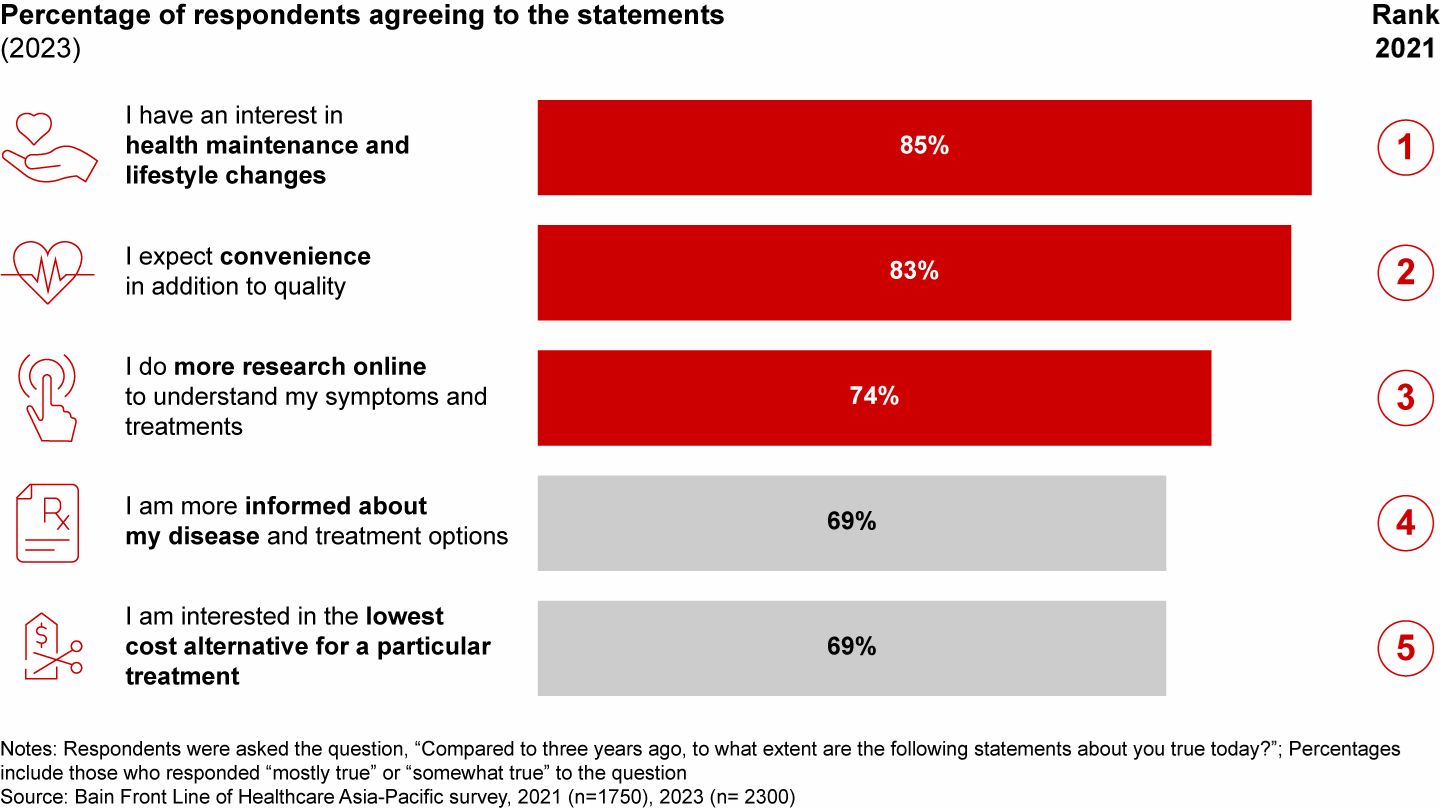
Consumers are increasingly willing to spend more on healthcare. According to 2023 survey results, 51% of Asia-Pacific consumers (58% of Gen Z) say they are willing to pay more out of pocket for healthcare in exchange for better health outcomes, better experiences, and greater efficiency.
The adoption of wellness trends, however, is more common among the “healthy and wealthy” group. In high-income groups, 50% reported spending more on nutritional supplements, compared to the overall population at 45%. Gen Z exhibits more active involvement in their healthcare compared to other age cohorts, with higher healthcare spending. According to our survey, the Gen Z population is especially focused on preventive products and services in the consumer health category, with a notable surge in demand for nutrition products such as vitamins and supplements (see Figure 2).
A strong desire to invest in proactive and preventive care through nutrition and supplement spending

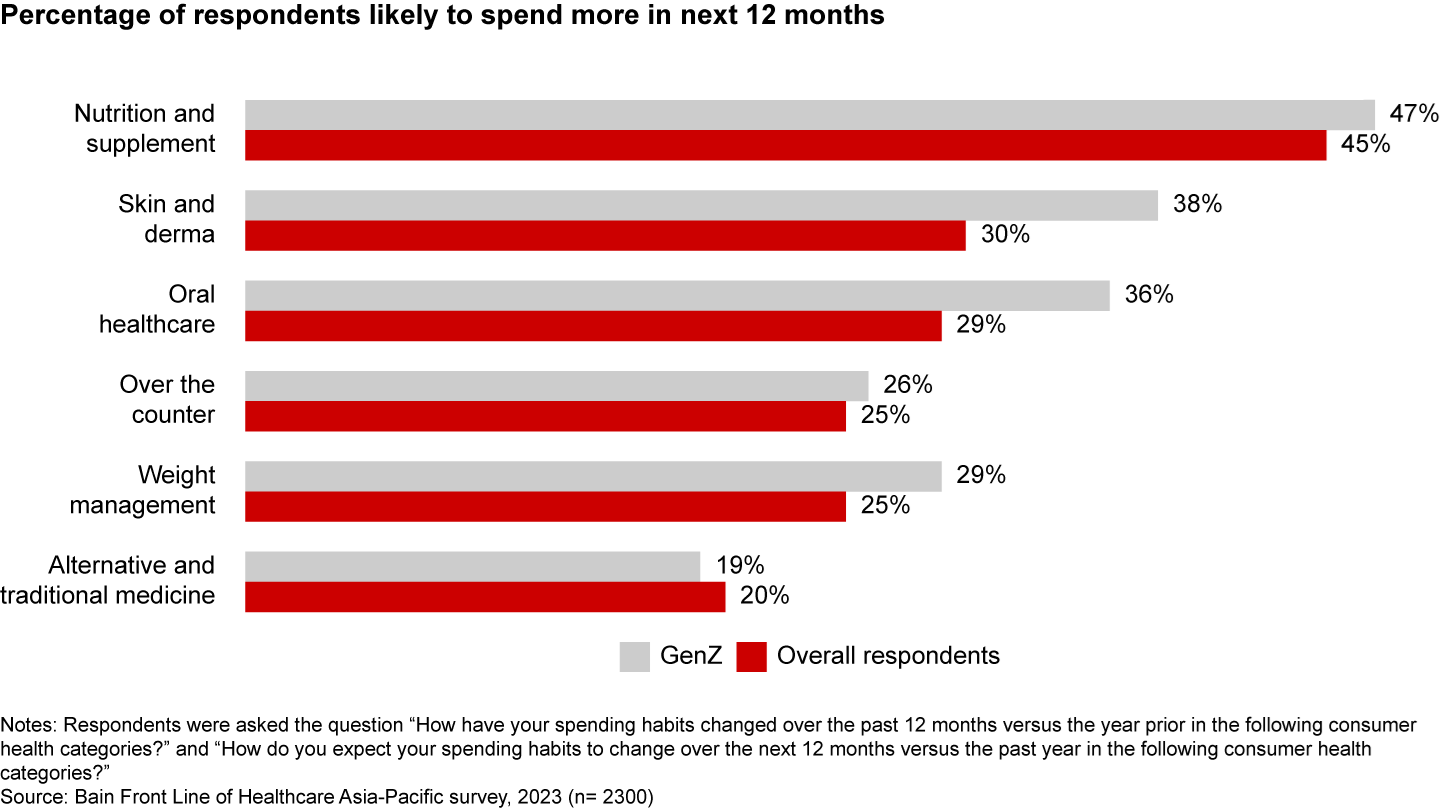
Care everywhere
The old notion of hospitals as the sole preferred or preeminent healthcare providers is slowly shifting across the Asia-Pacific region thanks to technological intervention, sustained focus on convenience, and a surge in consumerism.
Today’s patients want to explore care options that are both convenient and affordable. Accessible healthcare options—including wellness support and other non-acute care services—are becoming increasingly available at community clinics, pharmacies, and other non-hospital locations across the region.
Compared to our 2021 results, consumers exhibit greater comfort in 2023 about receiving care outside conventional hospital setups, particularly for routine check-ups and diagnostic services (see Figure 3).
Care is extending beyond traditional hospital settings

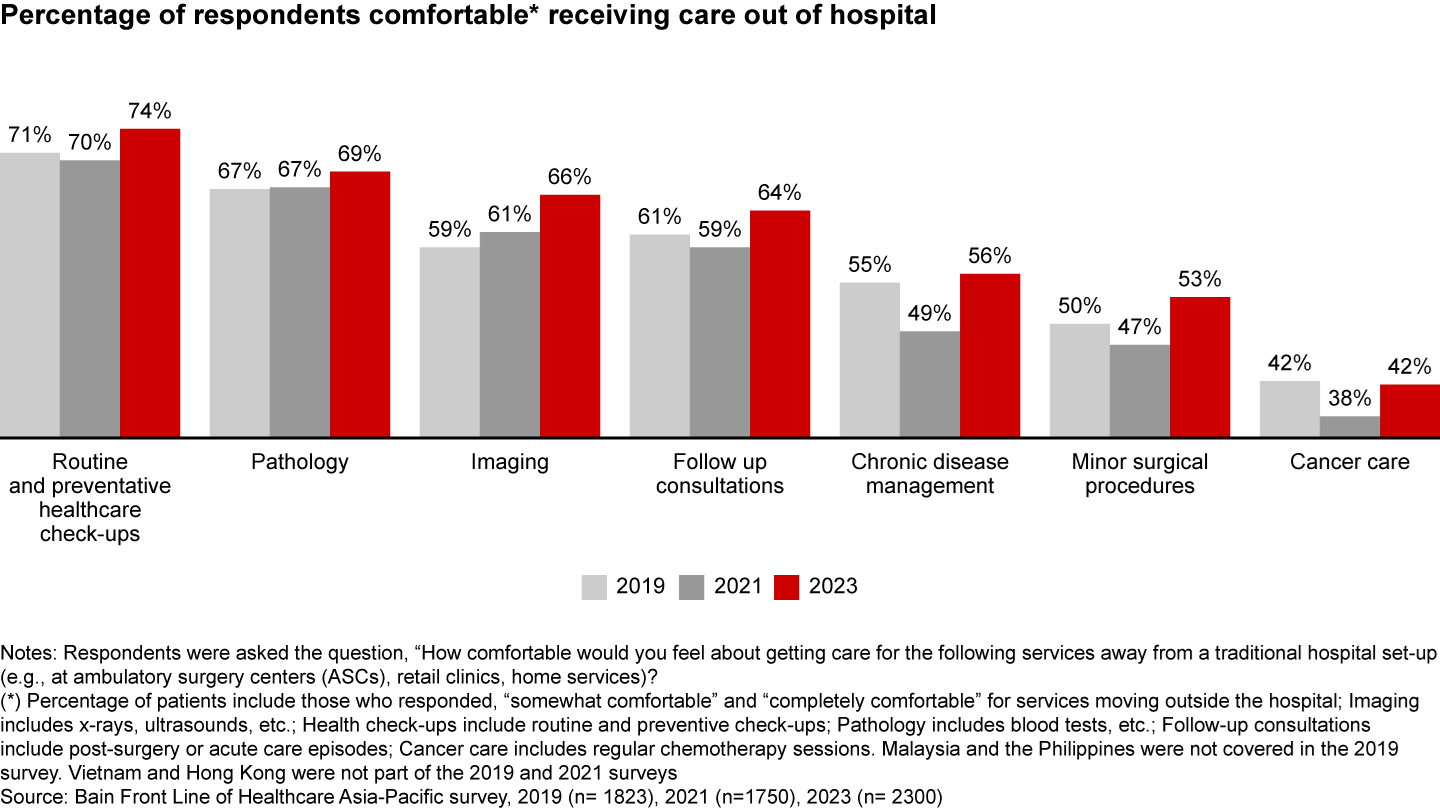
During the pandemic, many consumers received Covid-19 testing and vaccines at pharmacies, helping to normalize the notion that such places could serve as a point-of-care provider. As a result of these experiences, consumers are becoming more comfortable with accessing healthcare services at pharmacies. In fact, 2023 results suggest that at least 65% of consumers (74% in Gen Z) use pharmacies as a primary point of care.
The survey also suggests that in the future, the proportion of consumers willing to seek pharmacy-provided healthcare may increase to 73% (82% in Gen Z) in the presence of partnerships between pharmacies and other healthcare providers, including clinics or specialists. Our results found that between 70% of consumers in Malaysia, the Philippines, and Vietnam and 85% of consumers in China, India, and Indonesia are willing to consider pharmacies as their primary healthcare providers when partnerships with other healthcare providers are in place.
Based on our 2023 survey, we anticipate a significant increase in the adoption of pharmacy-provided services such as diagnostic services, health screenings, home delivery of medicine, and medication therapy management for chronic illnesses such as hypertension and diabetes (see Figure 4).
Potential for a pharmacy to transform into a healthcare partner

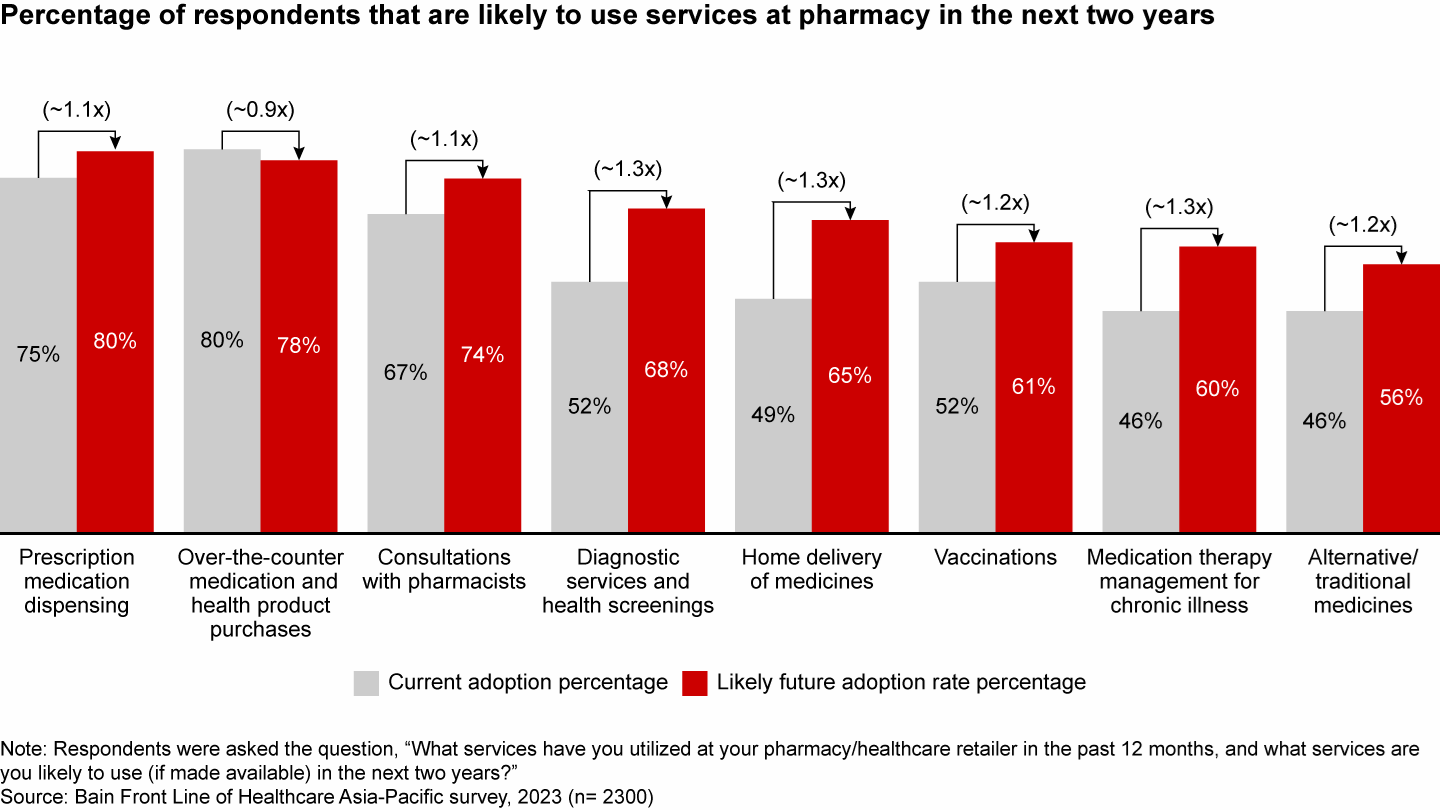
Our earlier surveys pinpointed a huge leap in telehealth adoption, which nearly doubled between 2019 and 2021 across Asia-Pacific. In this year’s survey, we observed post-Covid telehealth penetration growth slowing yet persisting across Asia-Pacific markets (see Figure 5).
Telemedicine is here to stay post-pandemic

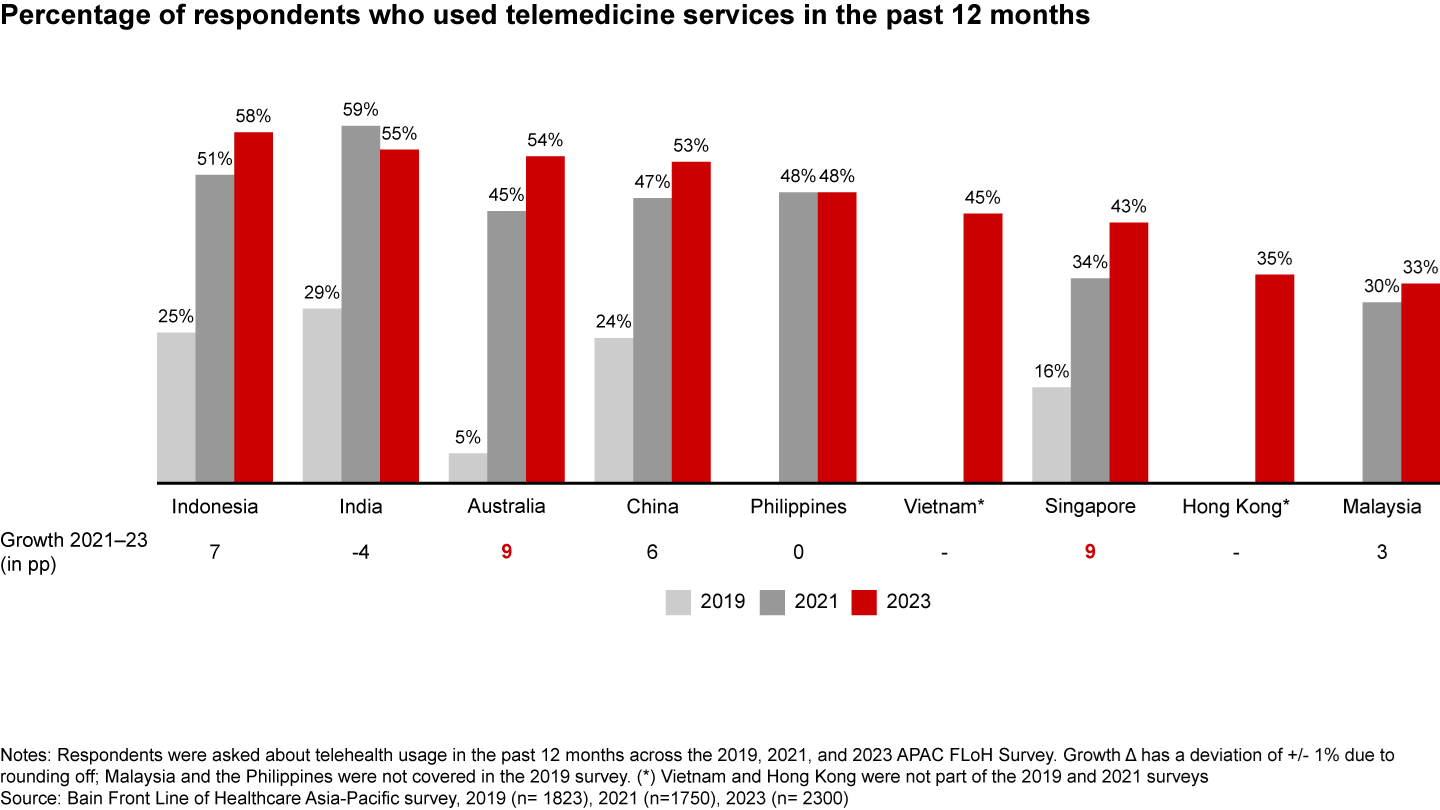
The benefit of telehealth is evident, especially in lowering healthcare costs. This is primarily attributed to the early triage and steerage to right side of care coupled with the low price point and pharmacy attach rate for teleconsultation compared to in-person primary consultation. For example, according to Halodoc, a telehealth and e-pharmacy platform in Indonesia, the overall cost of telemedicine (including consultation and medication) is three times cheaper than offline mode (see Figure 6). In addition to being cost-effective, online consultations demonstrated a high-solve rate of more than 95% for the top five online diagnoses (e.g., acute upper respiratory tract infections, nasopharyngitis, fever).
Telemedicine is three times cheaper than offline consultation in Indonesia, as per Halodoc data

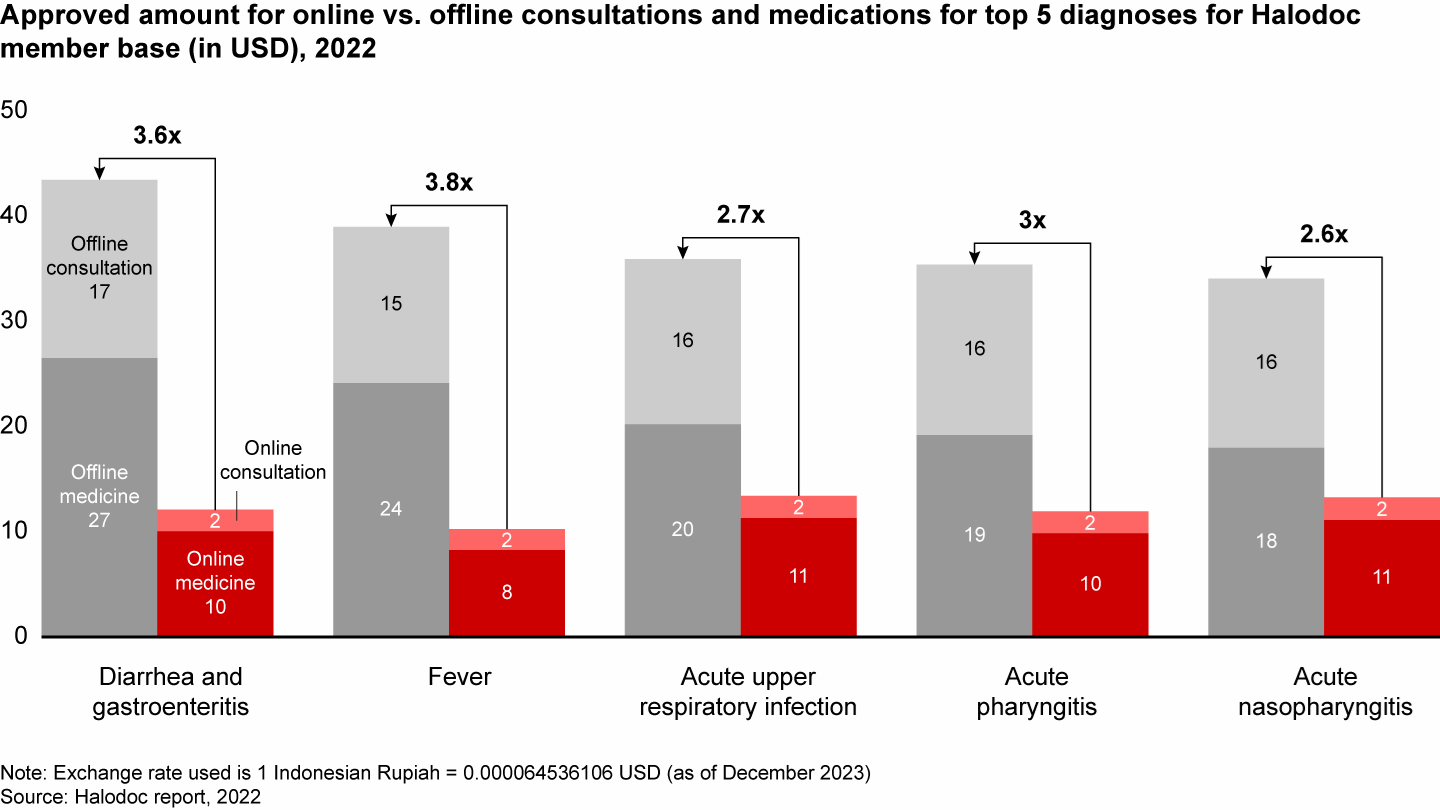
In response to the new digital norms, offline heritage healthcare providers are also doubling down on digital capabilities. In India and Indonesia, provider-owned apps from longtime healthcare players have nearly tripled their active monthly users in the past three years. For example, India-based provider Apollo Hospitals has worked to boost its digital services by launching its Apollo 24|7 app, where consumers can access services like video consultations, hospital appointment booking, and at-home medication and diagnostics ordering, all in one place. The hospital network has also expanded access to omnichannel care through its presence across a wide network of hospitals, clinics, diagnostics centers, and pharmacies, enhancing consumer experience and convenience.
Care management
Primary care is making a comeback post-pandemic: 91% of consumers prefer a single touchpoint to manage their health. Following trends evident in our survey findings, we continue to see strong consumer interest in a single, accessible touchpoint to manage their care.
In most markets where the primary care system is already established, digital health is not displacing primary care but supercharging its effectiveness.
A key exception is China, where digital health is helping reshape consumers’ care delivery preferences. There, 62% of respondents report preferring a virtual touchpoint of care—a trend that has, no doubt, been driven by lower accessibility to independent clinics and long wait times at hospitals (see Figure 7).
Consumers prefer single touchpoint to manage healthcare needs

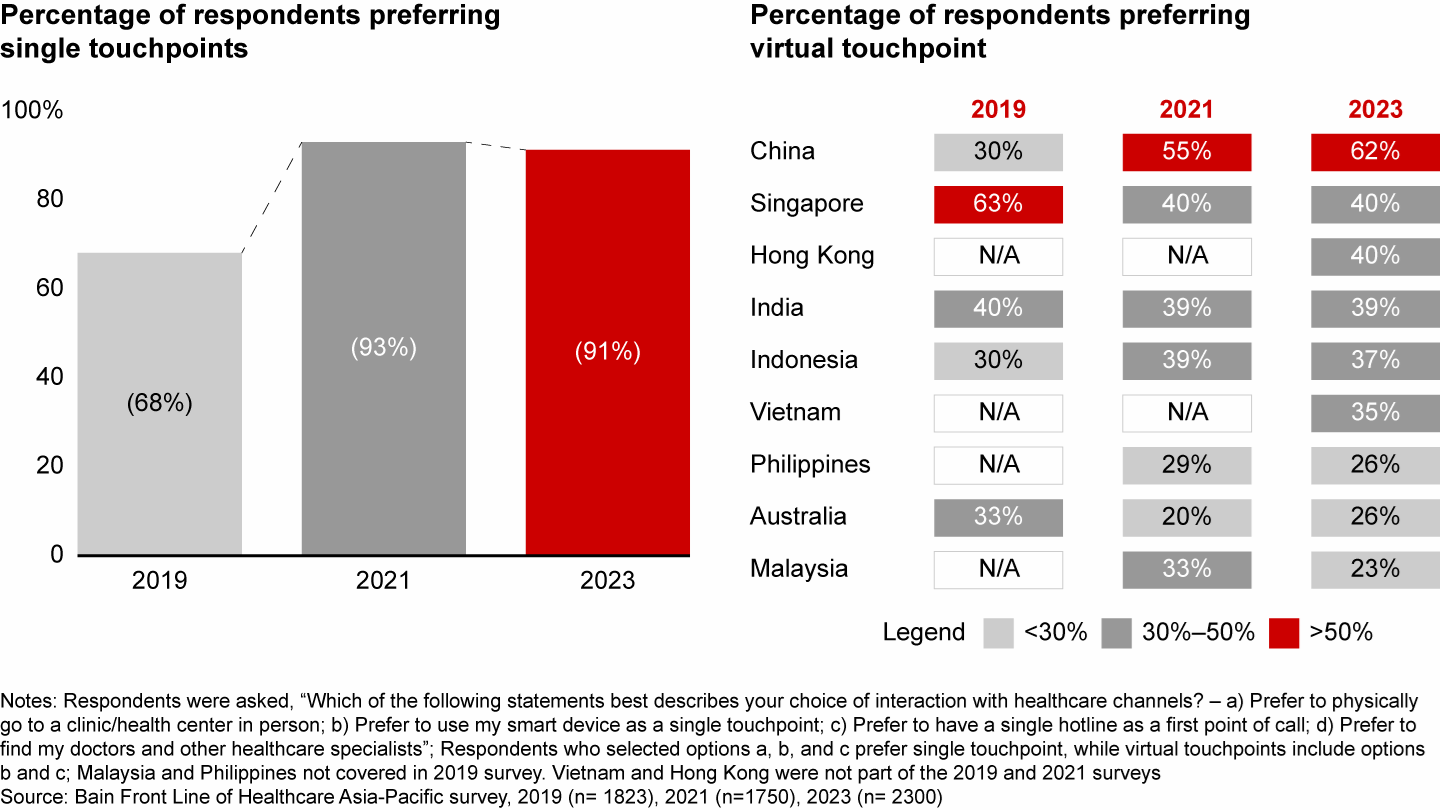
Consumers want a single touchpoint to manage their health. Who do they trust to manage and coordinate their overall healthcare needs? Primary care providers remain most trusted across many Asia-Pacific markets for managing overall healthcare needs. In China, Indonesia, and Vietnam, where there is a significant gap in the availability and quality of primary care services, consumers trust hospitals the most. We’ve also observed recent trends hinting at additional trust in non-traditional delivery channels, including retail health outlets and digital-first players, with consumers in India and Malaysia displaying high trust in pharmacies.
Roughly 70% of consumers in India, Indonesia, and China affirmed trust in digital health and tech companies to manage their healthcare needs. Meanwhile, offline providers still hold a roughly 40% trust advantage over digital players in Australia, Singapore, Malaysia, and the Philippines (see Figure 8).
Patients trust traditional care providers but are gaining confidence in pharmacies and tech companies

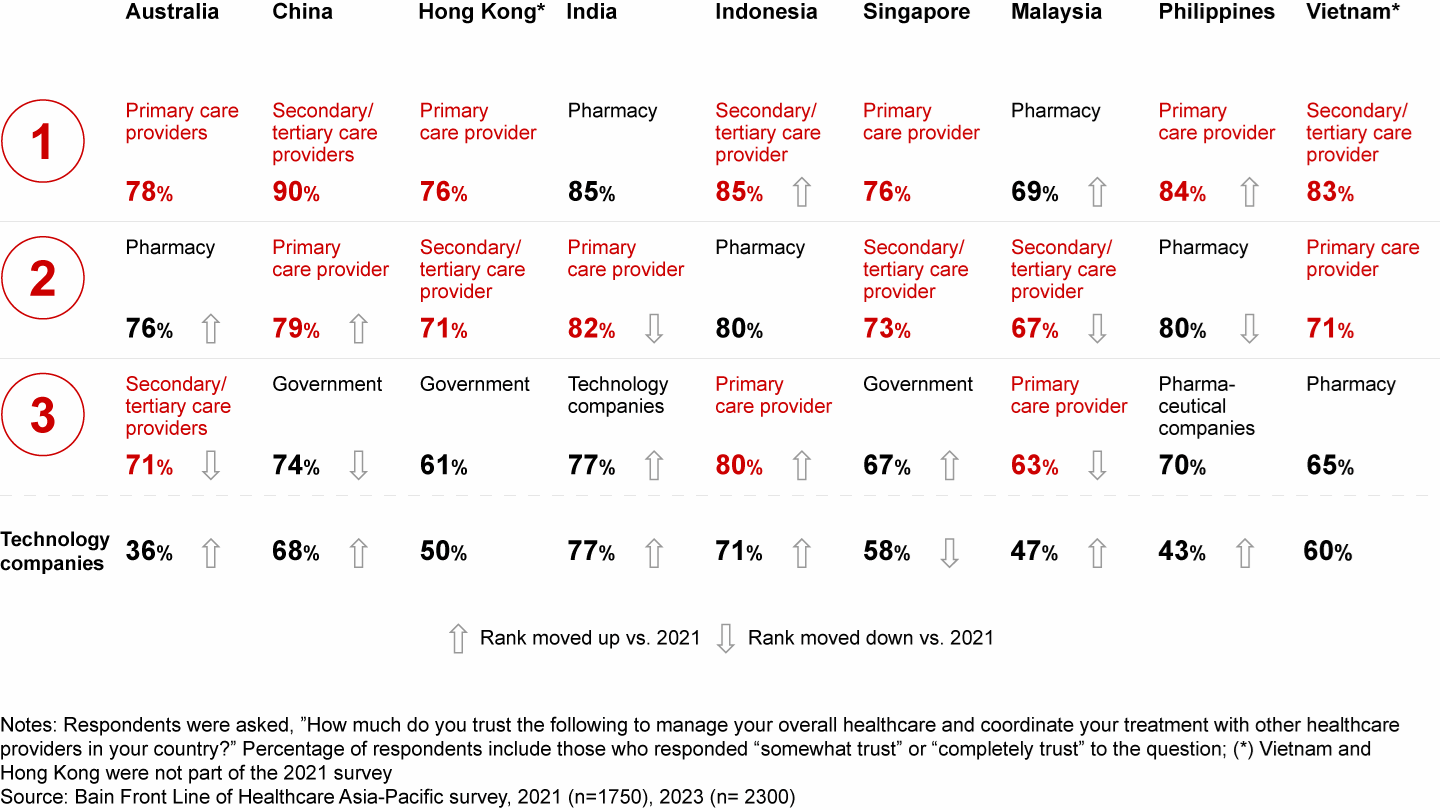
Our 2023 survey results also show that consumers seek integrated care pathways, especially in managing chronic conditions. Respondents highlighted the lack of affordable, accessible care and long waiting times at providers as key obstacles in their search for chronic care management. Many respondents noted a lack of adequate patient information or clarity on their care journey as other roadblocks to their care success.
As a result, new care models are emerging to address these concerns by delivering end-to-end integrated care delivery, bringing more affordable, accessible, and curated care to patients.
Additionally, players are enhancing capabilities and engaging in partnerships to provide integrated care to patients. For example, Singapore-based firm Doctor Anywhere, which specializes in telemedicine and other digital health services, acquired Asian Healthcare Specialists with 12 specialist clinics providing multidisciplinary services (e.g., orthopedics, ophthalmology). This strategic integration aims to enhance consumer access to secondary care services, promoting a seamless integration between online and offline services.
Today’s consumers expect payers to take an involved, guiding role in their healthcare journey. Roughly 80% of consumers look to insurance partners for specialist, diagnostician, or primary care provider recommendations. Consumers are also increasingly using insurance-backed digital apps, with roughly 50% penetration for services like online appointment booking, self-diagnosis, and digital claim management and is expected to rise to 70% in the next two years.
At the same time, healthcare-related claims costs are rising, with an expected 12% year-on-year increase in Asia-Pacific geography. For example, in Indonesia, as per Halodoc, women are more likely to see outpatient doctors compared to men but spend less on average for inpatient services. The Halodoc report also indicated that the offline outpatient and inpatient claim costs for older members were roughly six times higher (see Figure 9).
In Indonesia, inpatient claim costs are higher for older and male members, as per Halodoc data

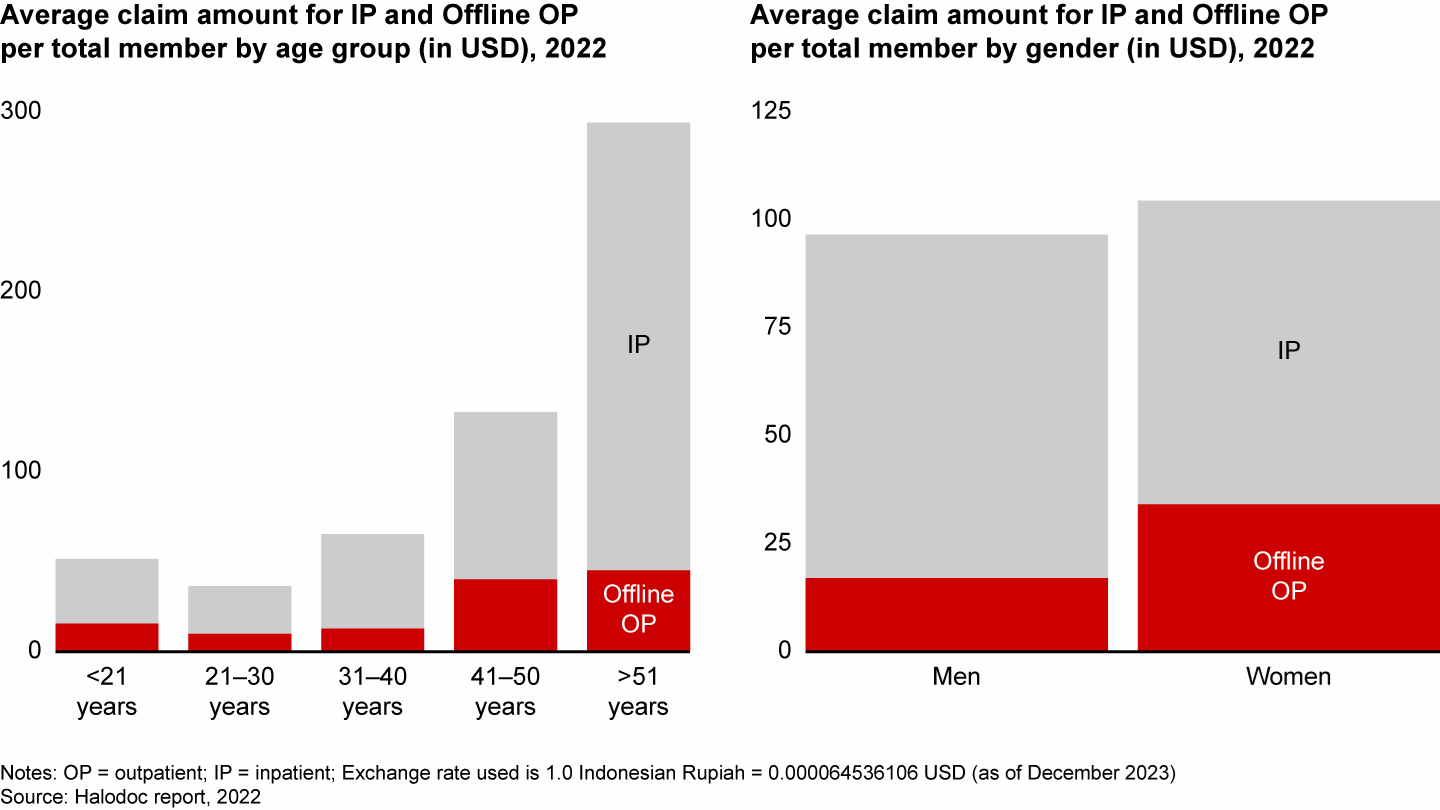
As consumers’ expectations change and healthcare claim costs rise, a new archetype of healthcare stakeholders has emerged: health insurers that manage patients’ health and wellness by enabling medical care. These “medicalized payers” offer more patient-centric care by integrating primary to specialty care services, coordinating care across providers and facilities, and improving health outcomes while reducing costs. Major insurers collaborate with healthcare players and digital insurgents, guiding customers in navigating their patient care journey.
Across Asia-Pacific, leading life insurance companies like AIA Group Limited and Prudential are investing significantly in health to build capabilities for coordinated care. For example, Prudential announced its “Transforming Health Business Model” as one of its three strategic pillars and is upgrading health insurance capabilities through advanced products and value-added services like personalized wellness services.
AIA partnered with Amcal and Guardian pharmacies in Australia in 2021 to provide its members with in-store screening services from these pharmacies. In partnership with Discovery Group, AIA launched “Amplify Health” in February 2022 to improve patient access to the right providers, enabling better care coordination based on patient-specific health risks. In January 2023, Amplify Health acquired AiDA Technologies, whose AI-powered suite aids in claims management through automatic fraud detection, data-driven claims processing, and underwriting, reducing service costs and improving operational efficiency for businesses.
Tech revolution
The Asia-Pacific region is overhauling its healthcare systems, owing to the significant healthcare gaps in emerging Asian markets. These gaps include the burden of disease, demographic transition, limited social health protection, supply constraints with low doctor-patient ratios, and overburdened traditional healthcare channels. To overcome these gaps, healthcare stakeholders have to adopt an open mindset to integrate technology applications, disrupting traditional delivery models to deliver consumer-centric care. Prominent health tech use cases include the rise of connected care systems for real-time monitoring, genomics for personalized treatments, augmented/virtual reality for medical training and patient engagement, and robotics plus automated systems to enhance patient experience. Each of these technologies is driving significant shifts in patient care delivery.
Technological advances are shifting care expectations from a consumer perspective. Consumers are increasingly embracing smart wearables, so players now have access to a wide range of personal health data, opening the door to more targeted, personalized care in the future.
State-of-the-art remote patient monitoring devices also shift care delivery by enabling accurate, real-time health monitoring for patients with chronic conditions such as heart disease and diabetes. Many providers now prescribe continuous glucose monitoring patches for diabetes management or continuous electrocardiogram smart patches for heart patients.
Health tech’s rising status as a key care delivery module will undoubtedly spur future partnerships between tech companies and healthcare players to pursue more effective, personalized care devices. Pharma and medtech players are already starting to engage with patients directly, leveraging digital health and smart devices for chronic disease management.
For example, AstraZeneca partnered with Adherium Limited to offer a mobile-based smart inhaler linked to a digital portal that tracks medication dosage and enables data sharing with physicians. The goal is for patients to properly adhere to prescription guidance, achieving better patient health outcomes. Similarly, M-Wear, a health wearable by Mindray, provides real-time patient health tracking for post-surgery or chronic care cases, providing doctors with reliable, real-time patient data and alerts if acute care intervention is warranted.
Among these technologies, AI-backed devices are netting distinctive investor traction, with reported cumulative deals of $9 billion in 2021 across the region. According to an analysis using Crunchbase data, China ($970 million) and Hong Kong ($250 million) boasted the highest funding, while Indian start-ups offering AI-driven health solutions recorded deals valued at $60 million. Clinical decision support and drug discovery use cases received the most investment funding between 2015 and 2022.
Consumers are also embracing AI in healthcare for enhanced access and better outcomes. According to our 2023 survey, more than 50% of respondents now feel comfortable with AI-powered healthcare delivery—including care delivery through AI only and healthcare providers powered by AI—for preventive and wellness care and less severe physical conditions (see Figure 10). However, for more severe or urgent physical conditions (e.g., persistent chest pain, coughing blood), 70% of consumers prefer to receive care through human healthcare providers only.
AI is poised to play a larger role in supporting healthcare decisions

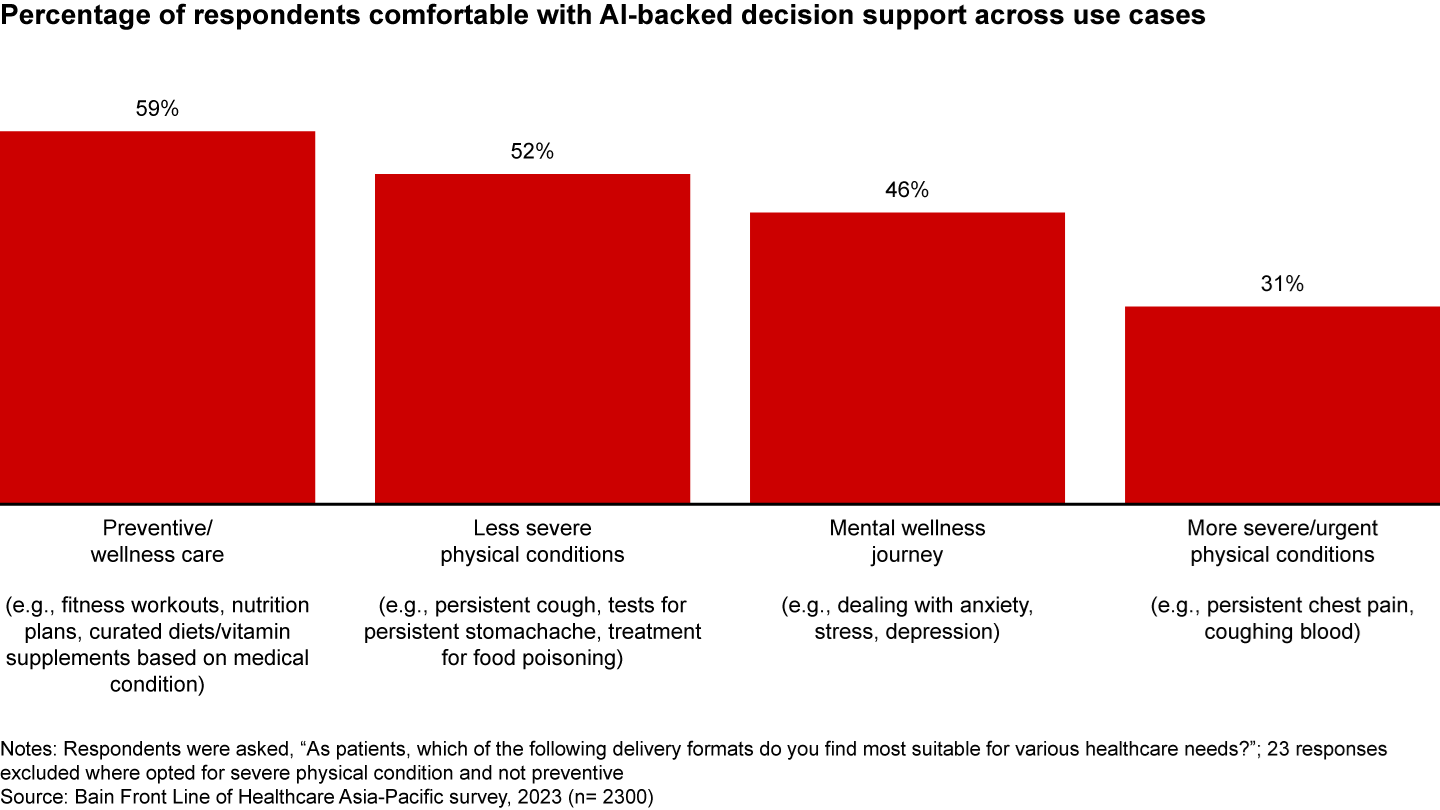
There has been a significant increase in healthcare technology adoption in the Asia-Pacific region over the past few years. Compared to 2019, only 22% of respondents in Asia-Pacific used telehealth services that involved a human doctor at the other end of the virtual platform; in 2023, over 50% of respondents are open to having AI as a facilitator in their healthcare delivery, particularly for preventive care and less severe physical conditions, demonstrating the substantial optimistic sentiment consumers now have toward the use of technology, especially AI.
Furthermore, in an environment where medical professionals are scarce, AI applications and technologies reinvent how care is delivered by supporting physicians’ abilities to make better clinical decisions and automating and streamlining hospital administrative tasks. Providers across the Asia-Pacific region are actively ideating and fine-tuning AI-powered tools for enhanced productivity, cost-effectiveness, and superior patient outcomes.
For example, India-based start-up Qure.ai aims to innovate radiology imaging analysis through AI-powered, automated clinical decision support tools. Their imaging solutions cover a range of specialties, with highly accurate image processing (over 90%) and reduced turnaround time (less than 20 seconds processing time for orthopedic scans) compared to traditional methods.
Strategic opportunities
Asia-Pacific healthcare continues to undergo dramatic shifts in consumer demand, technological integration, and available care delivery modules. To appropriately capitalize on both existing and forecasted trends, Asia-Pacific healthcare companies can focus on four key opportunities:
1. Reinvent customer experience
Most Asia-Pacific patients prefer a single touchpoint to manage their healthcare needs. While face-to-face interactions are more commonly preferred, the pandemic has increased acceptance of virtual touchpoints. Therefore, healthcare providers must strike the right balance between online and offline interactions throughout the patient care journey. Digital transformation involves seamlessly integrating online and offline experiences, embedding digital tools and processes, and connecting important workflows. With the help of technology, healthcare professionals can collaborate more effectively and provide patients with a seamless omnichannel experience.
Healthcare players should stay attuned to evolving consumer needs, including increasing demands for well-mapped, easy-to-navigate customer health journeys. Further, they should deploy mechanisms, such as Net Promoter ScoreSM, to measure their customers’ experience and demand for particular services. This will enable providers to effectively re-evaluate and re-design their services and delivery modules to match consumer preferences.
Additionally, healthcare players could look to tailor or curate services for targeted cohorts of patients. Awareness of demographic preferences—for example, Gen Z’s greater usage of nutritional care—can help shape providers’ customized offerings. This approach requires increased focus on need-based segmentation, personalized care, and tailored recommendations that match individual consumers’ needs to capitalize on current consumer trends.
2. Coordinate care delivery
As rising claim costs deeply impact payers, insurance providers should look for ways to integrate patient care management more effectively toward better care delivery. When payers play a greater role in patient steerage and guidance, they can help limit the need and associated costs of more severe diagnoses and treatments.
Specifically, to achieve better health outcomes and more optimized costs, payers could play a pro-active role in providing care guidance through services such as medical concierges and preferred panels. Payers can also focus on mapping the customer journey and identifying areas for intervention to assess different care management needs for the member population segment. This could be followed by designing an optimal operating model that meets business needs and customer expectations. Additionally, payers can’t do everything simultaneously and need to thoughtfully prioritize efforts where they can be only “good enough” vs. where they can create “delight” across the member segments.
Additionally, retail pharmacies could benefit from patients’ growing willingness to seek primary care services outside of conventional setups by extending their capabilities across additional service offerings. Pharmacies might build capabilities in-house and partner with other providers to deliver a suite of service offerings, including diagnostics, consultations, medication management, and more.
3. Future-proof technology infrastructure
Healthcare incumbents should look to digitize legacy processes and ensure front-end digital interface integration if they hope to maintain relevance in the modern healthcare market’s growing omnichannel delivery ecosystem.
The digitization of existing healthcare systems can increase efficiency and productivity gains for healthcare providers. This includes integrating more efficient patient record management, data-backed health insights, and clinical decision support tools.
The emergence of new technologies, such as robotics, AR/VR for workforce training, and generative AI for improving diagnosis and bringing efficiencies in admin processes, can further empower healthcare delivery improvements across the Asia-Pacific region. Healthcare systems are already widely using these tools to mitigate challenges due to staffing shortages without compromising care quality. One example is Apollo Hospitals in India, which has utilized Google Cloud’s Vertex AI and generative AI models to develop a Clinical Intelligence Engine tool as a clinical decision support system for doctors.
Finally, companies can concentrate on providing the necessary tools to further enable consumers to take control of their healthcare. Consumers are increasingly comfortable using smart wearables and digital apps for regular health monitoring. Players should leverage these emerging trends and equip consumers with innovative technology solutions to forge stronger connections between patients and healthcare providers, ensuring a more comprehensive and patient-centric approach to healthcare.
4. Forge strategic partnerships
With the growing traction for convenience-led integrated care points, healthcare players may wish to establish a presence across the entire care continuum. This goal will require building new capabilities and skills.
As these shifts occur, the Asia-Pacific healthcare sector will likely witness strategic partnerships across delivery formats and player archetypes—for example, between payer-backed providers, pharmacies powered by specialty clinics offering “one-stop shop” solutions, and pharma and medtech companies leveraging tech capabilities for better patient engagement.
Digital insurgents’ partnerships with incumbents could make for an interesting play as they offer superior digital capabilities while benefiting from the legacy player’s trusted brand and scale advantages.
What’s next?
The evolving trends discussed here are reshaping the future of healthcare systems, creating a more consumer-centric ecosystem that collaborates seamlessly with technology. To thrive in this changing landscape, healthcare players must embrace tech solutions and form strategic partnerships to develop new capabilities, delivering convenience-driven, integrated care across the entire care continuum.
By incorporating coordinated care strategies, healthcare stakeholders will focus on enhancing care management, improving health outcomes, and cost optimization while expanding their range of services.
About the research
Halodoc is a pioneer of Indonesia’s digital health ecosystem, offering a range of services, from telemedicine and health products delivery, home care services, to cashless outpatient services through partnership with insurance providers. The company is also committed to promoting wellness by offering comprehensive health solutions, from preventive to curative approaches in a single application.